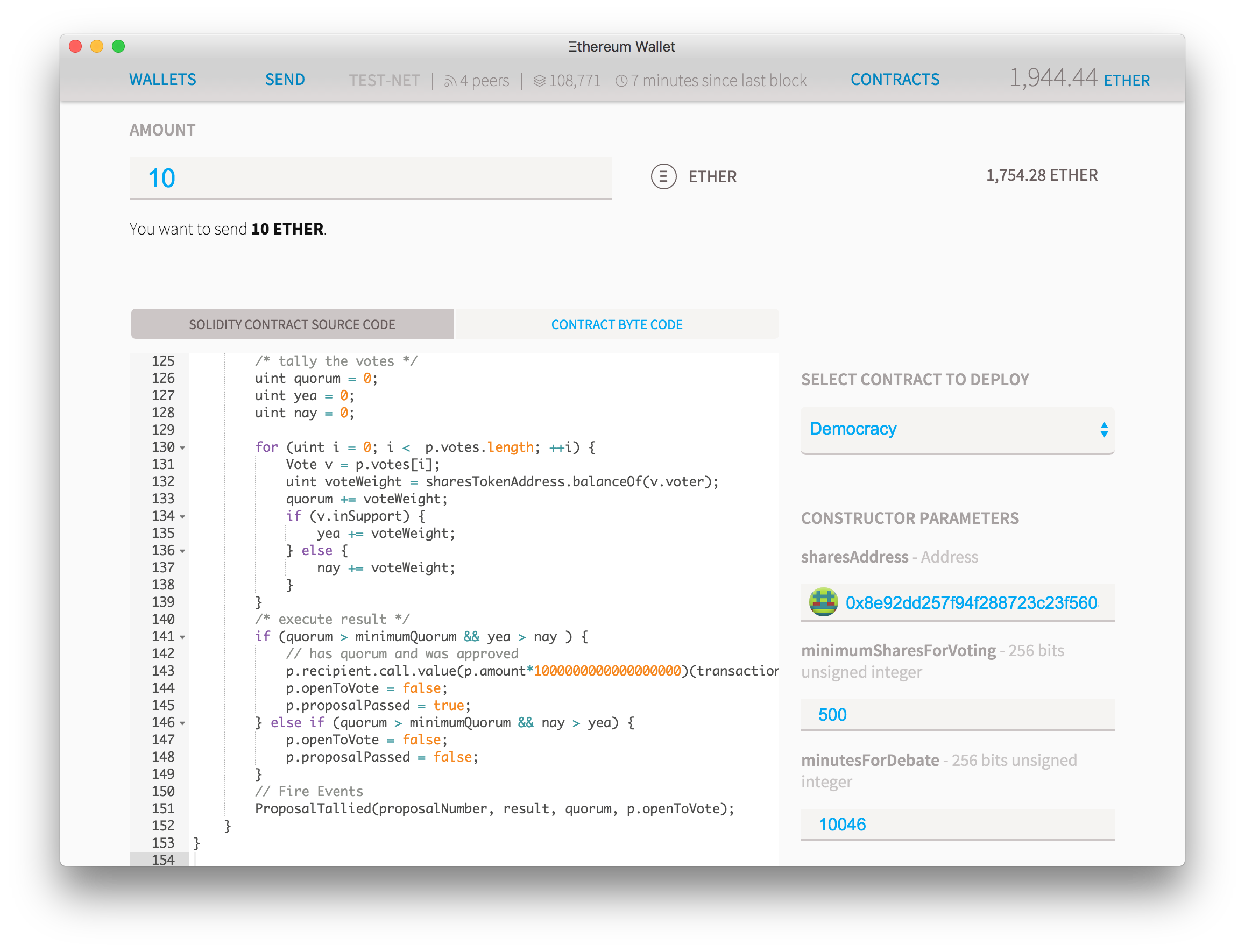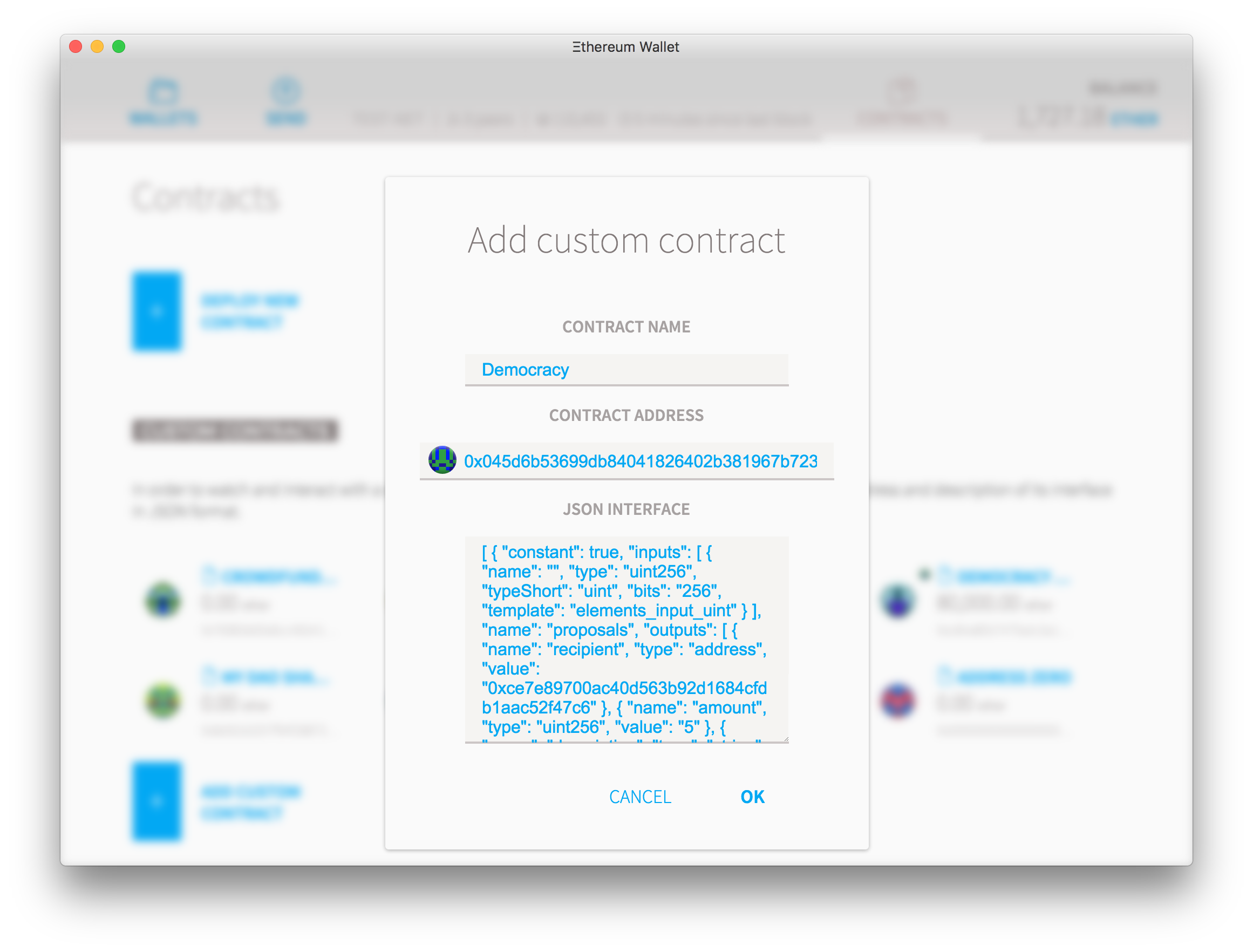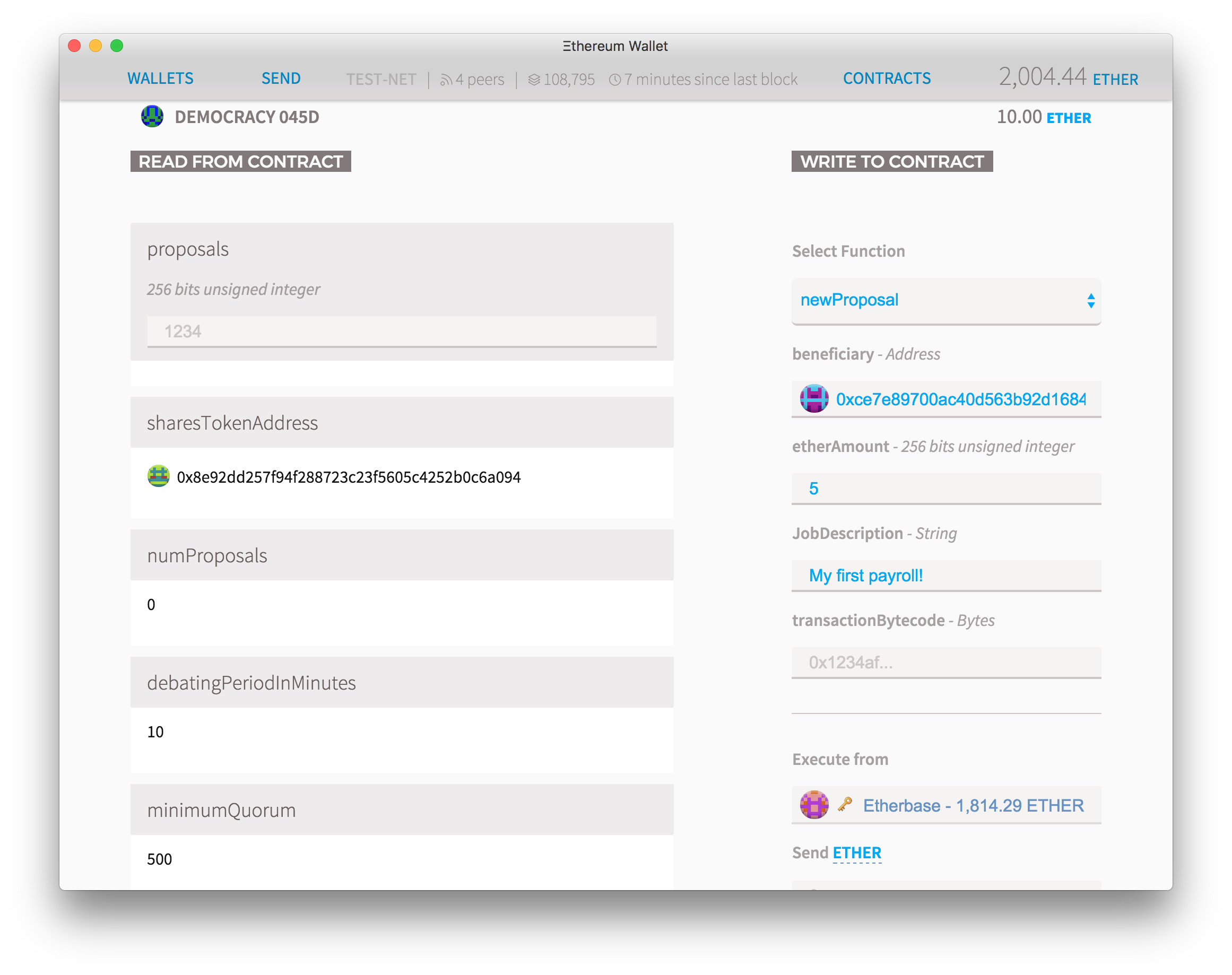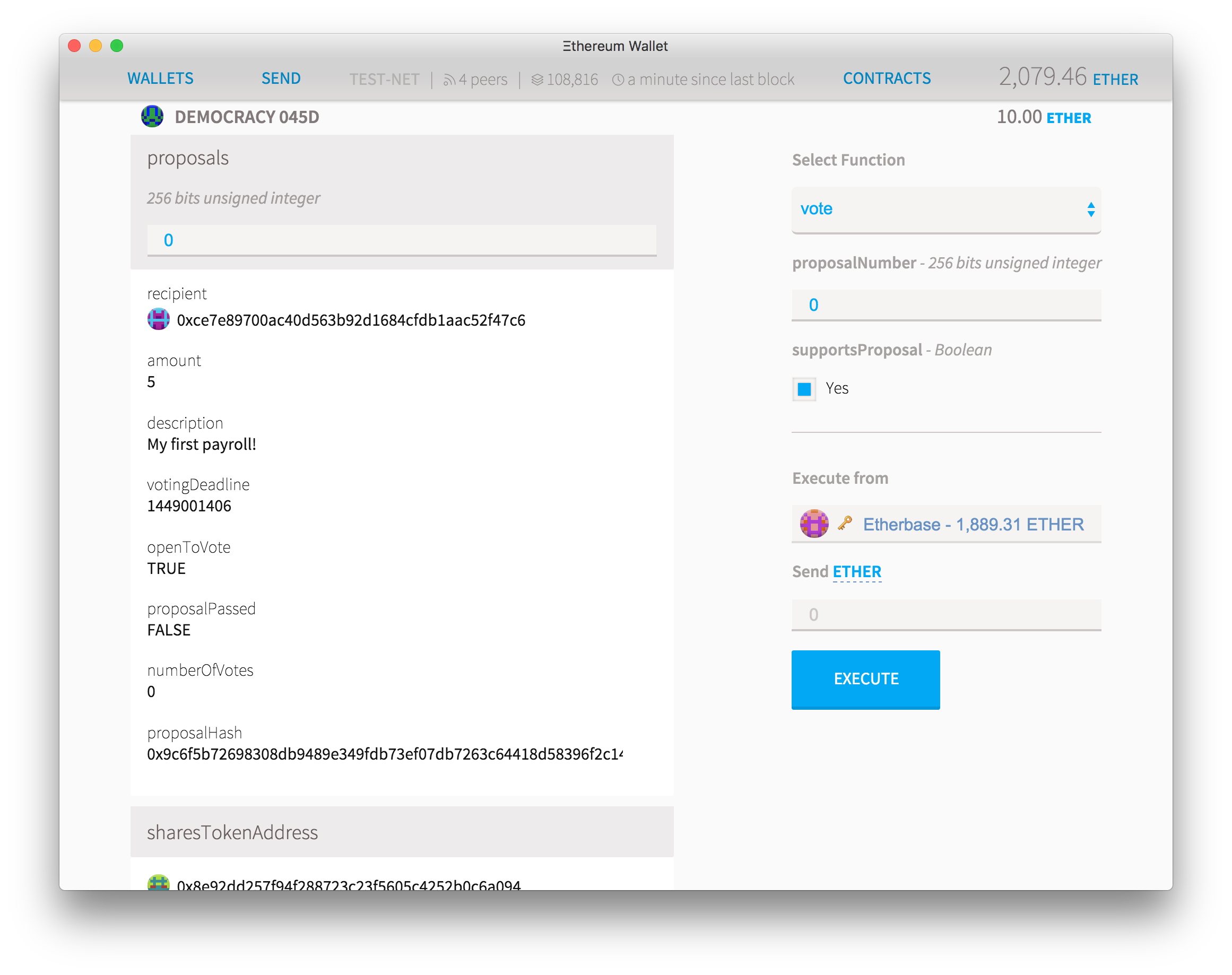[ad_1]
This can be a second submit on a sequence on find out how to use the present Ethereum instruments to construct sensible contracts while not having programming expertise. Download the latest version of the Ethereum Wallet, read the first part and let’s have enjoyable!
Creating a token is fun, however what’s the worth of a token that would not do something new? We are actually going to create a brand new contract that makes use of the tokens we simply created. The contract might be a Democratic group that lives on the blockchain and that anybody holding a share token will be capable of vote on proposals.
So let’s return to “Contracts” after which “Deploy Contract” and paste the DAO source code on the “Solidity Supply” subject. Select the contract “Democracy” on the Picker after which choose these parameters:
- On the quantity subject you’ll be able to add any ether quantity you need your DAO to start out with. Since you’ll be able to ship ether to it at any time sooner or later, if that is the primary time you’ve got been doing this then preserve the quantity at 0 and ship the cash later.
- On the sharesAddress subject, paste the handle of the token contract you simply created. Take note of the icon and colour of the little circle that seems by the aspect of the handle. If it doesn’t match precisely the one for the contract you created beforehand, then there’s an error.
- On minimumSharesForVoting decide what’s the minimal quorum of shareholders that have to vote on a problem earlier than it passes. Right here you will need to put the integer variety of the minimal token potential, so for those who created a token with 2 decimal locations, placing 500 right here will imply that to ensure that a proposal to be executed then the variety of votes have to be greater than 5% of the whole shares of the corporate.
- minutesForDebating: that is the minimal time a proposal have to be mentioned and voted on earlier than the outcomes could be tallied up. Put a small quantity like 10 minutes if you’d like simply to create one thing for testing, however put one thing like 20,000 if you wish to retailer massive quantities of ether, so all proposals should keep there for a minimum of two weeks.
Your contract needs to be wanting one thing like this:
After just a few seconds you may be redirected to a the dashboard the place you may see your new contract being created:
You can even see the hyperlink to the brand new contract on the “Contracts” tab. If it is not there (for instance: in case you are including a contract that you just did not create) then you definately’ll have so as to add it manually. So as to add that you will want the contract’s handle and it is JSON interface, a string of textual content that explains to the pockets find out how to work together with the code. You possibly can decide any title you need and press OK.
Click on your new contract field and you will see a contract web page. If you have not already deposited some ether on that contract, click on on deposit and put some small quantity of ether so you’ll be able to take a look at how this specific democracy works. If the contract already has some funds, click on the “present contract data” button.
On the “learn from contract” you’ll be able to see all of the capabilities you’ll be able to execute at no cost on the contract, as they’re simply studying info from the blockchain. Right here you’ll be able to see, as an illustration, that the “sharesTokenAddress” is certainly the right handle or that there are presently 0 proposals on the contract. Let’s change that.
On the “Write to contract” you will have a listing of all of the capabilities that may try to do some computation that saves information to the blockchain, and subsequently will price ether. Choose “newProposal” and it’ll present all of the choices choices for that operate.
For “beneficiary” add the handle of somebody you need to ship ether to, then put what number of ethers you need on the “etherAmount” (have to be an integer) and at last some textual content describing the rationale you need to do that. Go away transactionByteCode clean for now. Click on execute and sort your password. After just a few seconds the numProposals will enhance to 1 and the primary proposal, quantity 0, will seem on the left column. As you add extra proposals, you’ll be able to see any of them by merely placing the proposal quantity on the “proposals” subject and you may learn all about it.
Voting on a proposal can also be quite simple. Select “vote” on the operate picker. Kind the proposal Quantity on the primary field and examine the “Sure” field for those who agree with it (or go away it clean to vote towards it). Click on “execute” to ship your vote.
When the minimal voting time has handed, you’ll be able to choose “executeProposal”. If the proposal was merely sending ether, then you may as well go away the “transactionBytecode” subject clean. After urgent “execute” however earlier than typing your password, take note of the display that seems. If there’s a warning on the “estimated payment consumption” subject, then which means that for some purpose the operate known as is not going to execute and might be abruptly terminated. It could imply many issues, however within the context of this contract this warning will present up everytime you attempt to execute a contract earlier than its deadline has handed, or if the person is making an attempt to ship a special bytecode information than the unique proposal had. For safety causes if any of this stuff occurs, the contract execution is abruptly terminated and the person that tried the unlawful transaction will lose the all of the ether he despatched to pay transaction charges.
If every part went nicely it’s best to be capable of see the outcomes of the vote in just a few seconds. The “openToVote” parameter on the primary field will flip to false whereas the proposalPassed will replicate if the proposal has been accepted or not. You must also be capable of see that the Ether stability of the contract will go down and the equal ether might be despatched to the beneficiary of the ether you needed to ship.
Now take a second to let that in: you simply created a corporation that solely exists on the blockchain, that obeys votes primarily based on utterly digital tokens, however but it may possibly transfer actual worth round and create a really actual affect on the world. Additionally discover that the group is just not underneath your management anymore: it’ll execute solely the precise code you used to create it, eternally. You possibly can’t bribe it, you’ll be able to’t earmark it and the identical guidelines apply both you’re shifting 0.01 or 1,000,000 ethers.
Can it get any higher than this? Truly, it may possibly. On our next post we will explore how you can use “transactionBytecode” to allow the DAO to execute any kind of ethereum transaction, even proudly owning or creating different contracts. We’ll additionally modify the token code to permit the DAO to manage the quantity of a token that exists on circulation and find out how to ship it ahead.
[ad_2]
Source link









